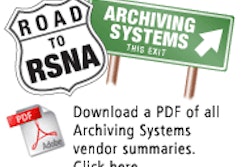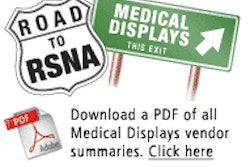Lossy compression techniques are effective in abdominal CT exams at a range of compression ratios, according to a pair of studies presented at the 2007 RSNA meeting in Chicago. In one paper, Austrian researchers judged 3D JPEG 2000 to be suitable at ratios up to 15:1, while in another study, a South Korean team found 5:1 JPEG 2000 to be visually lossless.
Lossy 3D JPEG 2000 compression ratios of up to 15:1 do not impair diagnostic accuracy or "diagnostic confidence of a given diagnosis," said Dr. Helmut Ringl of the University Hospital Vienna in Austria. He presented the team's results during a scientific session at the conference.
To retrospectively assess the effect of lossy 3D JPEG 2000 compression on diagnostic confidence and diagnostic accuracy of emergency abdominal CT images, the Austrian researchers studied 104 consecutive emergency abdominal CT exams of patients with acute abdominal complaints. All patients received CT scans on a Sensation Cardiac 64 (Siemens Healthcare, Erlangen, Germany) with 3-mm slice thickness and 2-mm reconstruction interval.
The images then underwent lossy, irreversible 3D JPEG 2000 compression (Aware, Bedford, MA) using 10:1, 12.5:1, and 15:1 ratios. The resulting four image datasets (including an original image dataset) were randomized.
Three radiologists then independently read the images at each of the compression ratios at a time interval of one month. They were asked to state the presence of compression artifacts, the diagnosis, and the confidence for diagnosis on a five-point scale (high = 5) for each organ. The diagnoses were then compared to a gold standard, which was created by an abdominal CT expert using the original image, as well as all available surgical reports, follow-ups, and patient records.
They found slight to moderate compression artifacts in the liver in 63% of the images at 10:1 compression, 73% at 12.5:1, and 89% at 15:1. The mean percentage of the correct main diagnoses for all three readers was 94.23%, 91.56%, and 92.57%. Compared to the 94.34% mean percentage for the original study, however, the differences failed to reach statistical significance (p = 0.16).
The mean confidences for all readers for the applied diagnoses were 4.816, 4.702, and 4.745. Those also did not differ significantly from the 4.726 mean confidences for the original image, Ringl said.
"However, the confidence of negative findings was moderately reduced at 15:1, so this is why we suggest 12.5:1 as an acceptable ratio," he said.
Lossy JPEG 2000
In another study presented in the same scientific session, a South Korean research team found positive results employing 5:1 lossy JPEG 2000 compression for abdomen CT studies.
"Irreversibly 5:1 compressed abdomen CT images are visually lossless and, therefore, potentially acceptable for primary interpretation," said Bohyoung Kim, Ph.D., a research scientist at Seoul National University Medical Center. She presented the team's research on behalf of lead author Dr. Kyoung Ho Lee of Seoul National University Bundang Hospital.
To estimate the visually lossless threshold for JPEG 2000 compression for abdominal CT images, the researchers studied 100 consecutive adult patients receiving contrast-enhanced abdominal CT scanning on a 16-detector-row CT scanner. The raw projection data were reconstructed into 5-mm transverse sections at 4-mm intervals, Kim said.
One image was randomly selected per patient, forming a 100-image set. The original images were then compressed using a JPEG 2000 algorithm (Pegasus Imaging, Tampa, FL) at a reversible compression level, as well as at irreversible ratios of 5:1, 10:1, and 15:1.
Six radiologists then read each of the 400 randomized compressed images, which were paired with the original image. Readers could selectively toggle between the two images on a single monitor; the original image was presented first, followed by the compressed image.
They could also adjust the window, level, and width, and also perform magnification, according to Kim. Each reader was asked to independently determine if the second image was identical to the first image, or if any detectable difference was present, Kim said.
The researchers found that for each reader the proportion that the compressed images were rated distinguishable from the corresponding original images was not significantly different between the reversible (0% to 1%) and 5:1 irreversible compression (0% to 3%).
However, the proportion significantly increased with irreversible 10:1 (95% to 99%) and 15:1 (100%) compared with reversible compression (p < 0.001). Overall, the readers rated 95% of the compressed images as indistinguishable from the original images (including 100% by five of six readers).
By Erik L. Ridley
AuntMinnie.com staff writer
January 16, 2008
Related Reading
Canadian research finds no loss with lossy compression, August 14, 2007
Enhanced DICOM objects, compression help with MDCT, MR challenges, March 23, 2007
Lossy 3D JPEG 2000 compression useful for abdominal MDCT, February 23, 2007
Canadian radiologists pursue lossy compression research, February 16, 2006
Image compression method may make large mammo datasets more manageable, December 22, 2005
Copyright © 2008 AuntMinnie.com



















